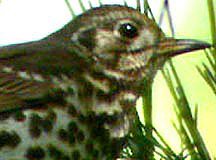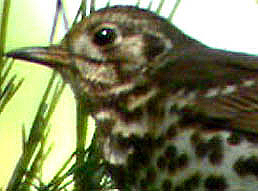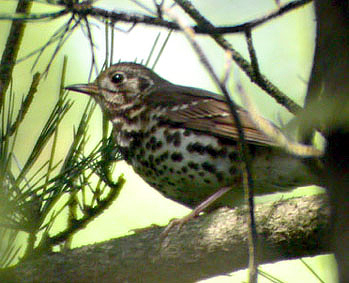Chinese (Song) Thrush Turdus munipensis

One seen and photographed on May 31, 2003, on Socheong Island, Gyeonggi Province (at approximately 37 D 31’ N, and 124 D 44’ E, approximately 220 Km east of the eastern tip of the Shandong Peninsula, eastern China).
Heavy rain and thick fog, with light winds, on May 29th 2003 led to large numbers of migrants being grounded on Socheong Island. Many of these were still present on May 30th and May 31st.
In bright sunlight on the 31st while checking the main gully and its stream (in the far southwest of the island), a rather bulky thrush, olivey-brown above and heavily-spotted below, was flushed from next to the stream into a low bush by a Gray’s Grasshopper Warbler Locustella fasciolata. Identification of the bird, observed through a tripod-mounted telescope at ca 30 m, was immediate as Chinese (Song) Thrush Turdus munipensis, and several digi-scope images were taken. The bird then flew up into a dense area of pines (with patchy low ground vegetation), where it loosely joined a Siberian Thrush Zoothera sibirica appearing significantly larger and heavier than it in direct comparison, before both disappeared out of view. Entering the pine coppice, the Chinese Thrush again flew up onto a branch, where it remained almost motionless, largely shaded and rather inconspicuous, for about 1 minute (when a second set of images was taken), before it then dropped down on to the ground out of view. The bird remained silent at all times.

Identification was based primarily on: (1) the very prominent dark grey-brown spotting, with many of the spots running together, on the otherwise whitish underparts (some even extending onto the undertail coverts); (2) the presence of a very prominent dark crescent to the rear of the ear coverts, which appeared to continue along the lower edge towards the neck sides; (3) the presence of a weaker second dark "tear" below the eye; and (4) the clearly defined whitish median covert bar, with a more poorly defined, slightly buffier greater covert bar. Separation from potential confusion species, especially female Grey Thrush Turdus cardis and the extralimital Song Thrush Turdus philomelos, was straightforward, based on the features detailed above, and also (5) by the bird’s obvious bulk - more reminiscent of a small White’s Thrush Zoothera daumathan either of those two species. Its bulky appearance was most obvious in short flight, but was also enhanced by (6) the strength of the orangey-based dark bill, and (7) the stout look of the "bruised pink" legs. Further plumage details, visible in the images, showed some slight differences from the description and illustrations in Clement and Hathway (2000), and are thus set out below with reference to them. It showed: (8) some slight rusty tones to the edge of the remiges on the closed wing, but the rump appeared rather concolorous with the rest of the upperparts; (9) only faintly darker edges to the tertials, with a very faintly paler outer edge extending round to the tips (which appeared worn and frayed); (10) a rather shorter primary projection, with much blunter-looking primary tips (partly attributable to wear?); and (11) a rather more complex face pattern than depicted.

The face pattern consisted of an ashy-grey-streaked-brown base, with five darker markings: two vertical blackish-brown marks (the one below the eye significantly weaker than the one to the rear of the ear coverts), a fairly prominent (moustachial?) stripe, that ran near horizontally from the bill’s cutting edge through the "tear" as far as the rear of the eye, a prominent dark malar stripe, and a dark patch above and behind the eye, setting off a rather prominent whitish eye-ring, which (therefore) appeared rather more prominent above and behind the eye. All of these markings were in turn contained within a pale frame, created by obviously paler and almost unmarked greyish lores and supralorals, which extended as a pale supercilium, before narrowing to a thin whitish line behind the rear dark ear covert crescent, to then run back below the ear coverts’ dark border, to eventually join up with the pale and apparently largely unmarked throat.

The Chinese Thrush is described as "uncommon to locally common" by Clement and Hathway (2000) within its limited range - China - and largely sedentary throughout. However, B. Johansson (in lit.) states that a few are seen each spring on Happy Island, in Hebei, with several singing annually inland at Laoaling/Old Peak (outside of the mapped range given by Clement and Hathway, 2000), while the same authors state that it occurs as a "scarce or rare spring and autumn migrant on the coast" of Hebei at Beidaihe and "possibly elsewhere". As it has also been recorded in Shantung (Shandong?) Province and once in Vietnam, they presume it is a partial migrant, with northern birds moving furthest south. If some of the northern populations do indeed undertake such significant migrations, it appears highly likely that the species will be recorded again, at the very least irregularly, in South Korea.
References:
- Clement, P. and R. Hathway. (2000). Thrushes. Helm Identification Guides.



